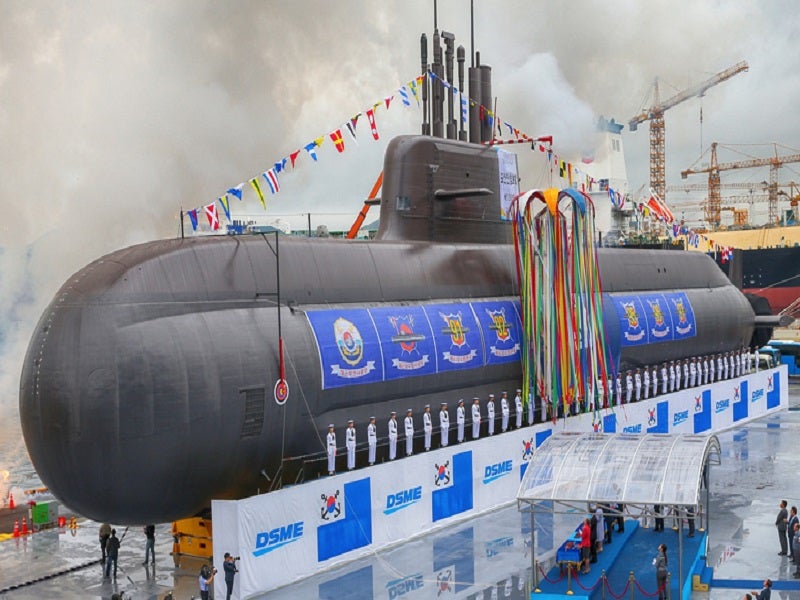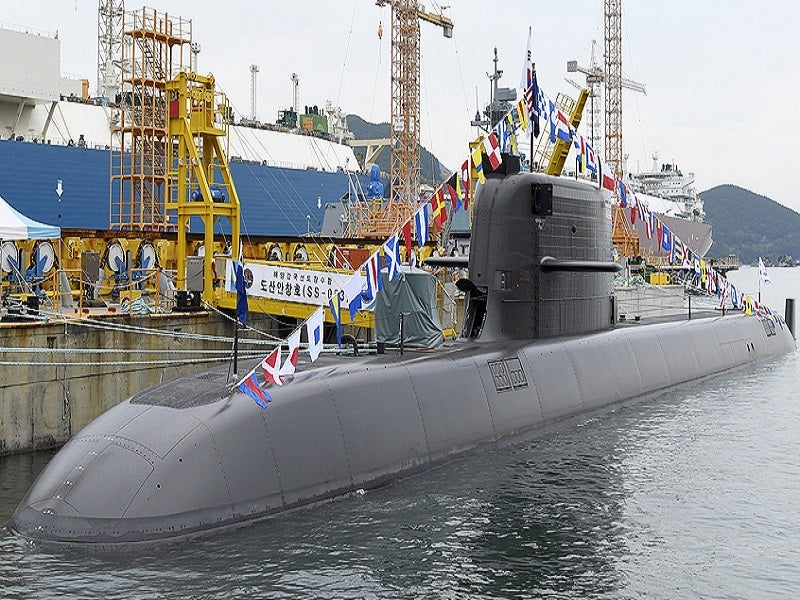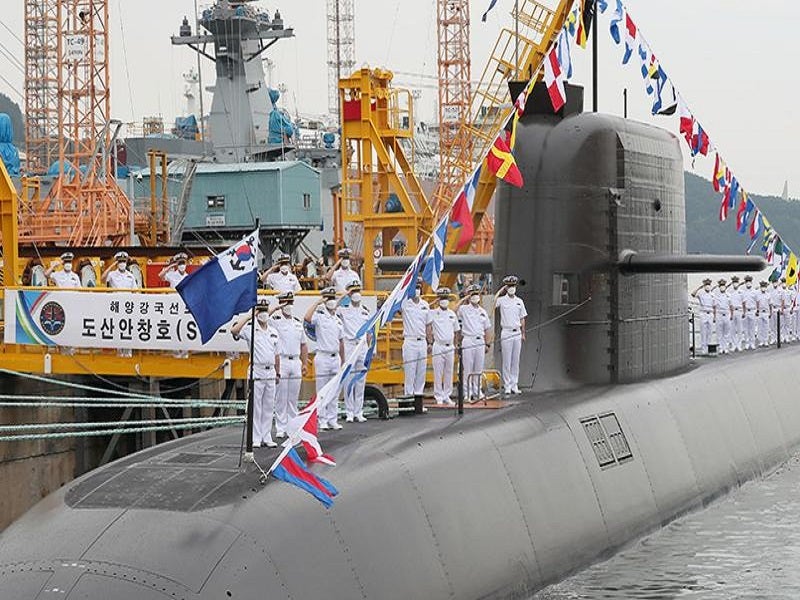KSS-III (Jangbogo-III) class, also known as Dosan Ahn Chang-ho class, is a series of next-generation diesel-electric attack submarines being built to strengthen the naval defence capabilities of the Republic of Korea Navy (RoKN).
The KSS-III project involves the development of nine attack submarines being built in three batches as part of South Korea’s indigenous submarine production programme.
The first and second hulls of Batch-I were built by Daewoo Shipbuilding & Marine Engineering (DSME), while the third was constructed by Hyundai Heavy Industries (HHI).
Batch-II will include three submarines, with some design changes from the Batch-I hulls. The remaining three submarines will form Batch-III and feature even more advanced technologies.
KSS-III class development details
The Agency for Defence Development (ADD) of South Korea issued a total of five requests for proposals (RFPs) for the KSS-III submarine project in February 2009.
The Ministry of Defence of South Korea awarded a contract to DSME in December 2012 for the construction of two KSS-III Batch-I submarines. The contract for the third Batch-I submarine was awarded to HHI in November 2016.
The steel-cutting ceremony of the lead submarine of the KSS-III Batch-I, Dosan Ahn Chang-ho (SS-083), was held at DSME’s Okpo shipyard in November 2014. The submarine was launched in September 2018, while commissioning took place in August 2021.
The keel for the second submarine, Son Byong-hi, was laid down in July 2016. It will be delivered by the end of 2022.
Construction of the third and final submarine of Batch-I began at HHI’s shipyard in Ulsan in June 2017. Named Yi Dongnyeong, the submarine was launched in September 2021.
The construction of KSS-III Batch-II submarines was approved in March 2019. South Korea’s Defense Acquisition Program Administration (DAPA) selected DSME for the Batch-II basic design in May 2016.
The last and final submarine of the project is expected to be delivered by 2029.
A steel-cutting ceremony for the second Jangbogo-Ⅲ Batch-II submarine was held at DSME’s facility in Geoje in December 2021.
Construction of the first Batch-II ship is expected to be completed by 2026, while delivery is expected by 2028.
Design and features of Jangbogo-III submarines
The KSS-III Batch-I submarines are 83.3m long, 9.6m wide and have a draught of 7.62m. With a gross tonnage of approximately 3,000t, the submarines are capable of accommodating a crew of 50.
The submersibles can be operated and controlled using steering and diving consoles developed by ECA Group. A numerical autopilot in the consoles allows for operation and control of the submarine in automatic, manual and mixed modes.
The submarines carry continuous active sonar (CAS) and flank array sonar (FAS) for detection, classification and localisation of targets.
The KSS-III-class is also integrated with a combat management system developed by Hanwha for the armament assignment, target detection and tracking, and engagement in linkage with the sensors.
The Batch-II submarine will be larger than the Dosan Ahn-Changho (SS-083) submarine. It will handle more armaments and feature an improved combat system and sonar system. The ship will have an enhanced stealth level and underwater operation capability.
The Batch-II submarine will feature an overall displacement of 3,600t. It will have a total length of 89m and width of 9.6m. The maximum speed and crew accommodation capacity will be the same as the Batch-I submarines.
Armament of Batch-I submarines
KSS-III Batch-I submarines are fitted with six vertical launch system (VLS) tubes and eight 533mm torpedo tubes. The boats are also capable of carrying cruise and ballistic missiles.
The first and second submarines in Batch-I are equipped with Babcock’s weapons handling and launch system (WHLS).
The WHLS incorporates air turbine pump (ATP)-driven positive discharge and programmable firing valve launch (PFV) system. It offers compatibility with missiles, torpedoes and mines produced by suppliers in Spain, South Korea and the UK.
Sensors and navigation systems of KSS-III Batch-I submarines
The Batch-I submarines are equipped with Safran Electronics & Defense’s new generation electro-optical surveillance masts, which feature high image resolution and processing capabilities.
The submarines are integrated with a signal intelligence (SIGINT) system and infrared (IR) system for discreet communications. A Link 11 tactical data link is installed to facilitate secure data transfer.
The navigation aids on board the submarines include an inertial navigation system (INS) and global positioning system (GPS).
The submarine also features marine radar, Pegaso electronic support system (ESM), active sonar and towed array sonar for detection of targets. Pegaso enables almost 100% probability of interception of aircraft and ship signals.
Propulsion and performance of KSS-III Batch-I submarines
Powered by a diesel-electric, fuel-cell air-independent propulsion (AIP) system, the KSS-III Batch-I submarines are capable of conducting long-distance underwater operations for up to 20 days.
The Batch-II series will incorporate lithium-ion battery technology as well as the AIP system.
The submarines can attain a maximum operating speed of approximately 20k and cruising range of 10,000nmi.
Contractors
Sagem (now Safran Electronics & Defense) was awarded a contract by DSME to supply its new generation electro-optical surveillance masts for integration onto the first two Batch-I submarines in October 2014.
Babcock was awarded a contract by DSME in September 2017 to design and produce WHLS for the first and second Batch-I submarines through to 2024.
DSME placed a contract with ECA in June 2020 for the supply of the steering and diving consoles for the first KSS-III Batch-II submarine. Delivery of the equipment is scheduled for 2023, and the operational tests will be completed by 2027.
Hanwha is supplying the combat management system for both the Batch-I and Batch-II submarines, while LIG Nex1 is providing flank array sonars.
Spanish technology company Indra Sistemas received a contract from DSME to supply its Pegaso electronic defence system for the first Batch-II KSS III submarine in November 2021.









